
When I was growing up in Red Hook, our family garden was an integral part of our life. Practically everyone in the neighborhood had one.
It was pretty much the norm that if you were Italian, there was a garden of some sort in your backyard, side yard, front yard, or even on a piece of purchased property elsewhere. If there wasn’t a yard available, you might offer to do the gardening in another’s yard and split the produce.
Even a stray public property somewhere may be found flourishing in the summer with tomatoes or beans, courtesy of an Italian who sought to make use of otherwise wasted soil. And widows or the elderly were guaranteed visits from neighbors bearing gifts of fruits and vegetables from their yards, so no one should, God forbid, go without eating something fresh from the ground. This is inherently who Italians are; creatures of producing, conserving, providing, and eating abundantly from the earth that was gifted to them.
Someone I once met from the north of Italy said that he admired America, especially the money our country spends on medical research, something very much lacking in Italy. “But,” he said, “it is a terrible thing to be poor here. In Italy, you can be poor, but you will never starve.”
This is a certainty, because if there is one thing that I have often relayed to my own children about growing up Italian in Red Hook, it was the reality that while we were poor, we ate like kings. All the produce we harvested was jarred and preserved to get us through the winter. Tomato sauce, roasted peppers, artichokes, pesto, beans, and even foraged mushrooms were mainstays of our winter dinners. And wherever there was a garden, there was usually a winemaker as well.
On our block alone, all the Molese longshoreman—after putting in serious hours of work on the docks—came home to tend to their gardens.
Chances were our neighbors were all eating the same things, too. If the string beans were coming in, most of us were home devouring them with fresh cooked tomatoes and spaghetti. It was common to look out our backyard windows and see fathers and grandfathers working quietly and diligently as they thinned plants, tilled dirt, pinched and pruned leaves, seeded, grafted and staked their plants for ample growth.
Many had even brought their tools from Italy. It was as common in the house to compost as it was to eat. And I never met an Italian who was intimidated by the aspect of growing anything. It was second nature; something they intuitively understood, enjoyed and took pride in.
This is the essence of the Italian gardener, but it is hardly the whole scope of their capabilities.
For generation, Italian gardeners have passionately and with much finesse parlayed their farming and gardening skills from their homeland to the soils of American cities and suburbs, oftentimes bringing with them cuttings and seeds of the very vegetables and fruits indigenous to their hometowns, and growing them against all sorts of challenges.
Italian Garden Project
This is one of the many reasons why Mary Menitti, founder of The Italian Garden Project, has proposed documenting immigrant gardeners as an integral part of Italian American history.
Her vision and project mission is to “celebrate the joy and wisdom inherent in the traditional Italian American vegetable gardens, preserving this heritage, and demonstrating its relevance for reconnecting to our food, our families, and the earth”
She has a five-year plan to document 100 gardeners across the country and plans to archive some of them in the Smithsonian Institute’s Archives of American Gardens, which will be available to researchers, educators and gardening enthusiasts now and in the future.
She is also developing two books: a children’s book about a grandfather’s love of his fig trees, and a coffee table book titled Food, Family, and the Earth: Reflections on the Italian American Vegetable Garden. The project has also incorporated an Heirloom Seed and Fig Tree Collection.
Pittsburgh born and raised, Mary Menitti’s impression of Italian gardeners is that they are so old world, that they are almost cutting edge in today’s society. She wants to capture this immigrant, generational way of life in America that could eventually be lost if not passed down to younger generations. She believes bringing these gardeners to the fore, perhaps inspiring future generations to continue this legacy.
Two years ago, Mary started to expand her project’s search for gardeners in the New York area. I was privileged to meet her at a culinary event in Eataly in Manhattan where she was showing photo slides of Italian gardeners in Pittsburgh from the Molise (Abruzzo) region of Italy. She explained that the recipes cooking in her demonstration were derived from those very gardeners and their wives.

Following the recommendations of both Vito Parente, president of the Molese Social Club on Court Street, and member Vito Pietanza, we were able to visit, document, photograph and archive seven Italian American gardens spanning Brooklyn, Queens, Staten Island and Long Island.
I was welcomed into these very private and immigrants’ gardens as they happily guided us through their sustainable oasis.
One can’t help feeling that they know they’ve got it—what it takes to make the earth perform for them. But they never seem to question why Americans don’t. They are only too happy to share what they grow with us.
Vito Gentile, Tony Troia and John Ranieri were among the seven who were selected to be documented in The Italian Garden Project website. Gentile, for instance, a jovial retired Red Hook longshoreman, has a flattering backyard where his grapevine is trained to accent and decorate the perimeters of his backyard, including a whimsical crowning along his free-standing garage—an excellent use of space.
He has at least twelve dwarf fruit trees that live side-by-side on his beautifully-built home’s back and side yards that produce persimmons, peaches, apples, pears, chestnuts, apricots and figs.
Threading their way in and around these trees and bushes are very lovely berry vines, providing vibrant color and aroma in addition to pounds of raspberries and blackberries.
The vegetable garden is lush and full with the vegetables that he and his wife, Lina, enjoyed as children in Italy. The typical ciccoria (dandelion) that Mola is noted for as a healthy addition to cook with beans or add raw to salads, grows there. His fagoli (bean) pinti, a popular Molese string bean that is a slimmer and more tender version of a standard “string bean,” also grows there.
I have to mention Vito’s absolute love of growing his Molese tomatoes (pomodoro apruni), an incredibly medium-sized, tasty tomato that is comparable to a compari tomato. In Mola, these tomatoes were well sought after because of their naturally salty flavor that came from the irrigation flow off the Adriatic sea. His wife Lina enjoys harvesting, cooking, and preserving everything Vito grows. She claims, “nature gives us what we need, it is up to us to take advantage of it.”
For more information about the Italian Garden Project, please visit TheItalianGardenProject.com








